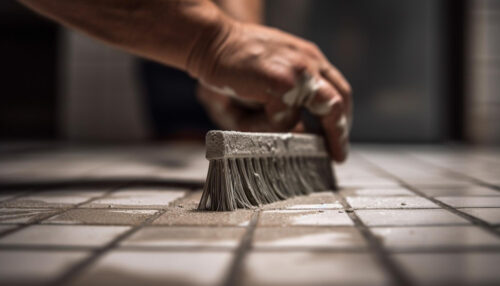Can you use brush-in grout for porcelain?
Grouting is the norm when it comes to outdoor paving, although in some cases it is possible to install no-grout porcelain tiles for a seamless look
Grouting is the norm when it comes to outdoor paving, although in some cases it is possible to install no-grout porcelain paving tiles for a seamless look.
Generally, though, this is not recommended for high-traffic areas, or locations where the tiles are exposed to harsh weather conditions.
The good news is that you can still achieve a much-desired sleek minimalism for your outdoor paving project with the right type of grout.
Understanding porcelain tile grouting
There are a number of reasons why grouting its important:
- By forming a barrier, it protects your porcelain paving from dirt and moisture that can so easily cause damage
- Grouting allows slabs a bit of movement which minimises risks of cracks forming
- It stops weeds from sprouting up between pavers
- You can get creative with your paving by using grouting in contrasting colours
What is brush-in grout for porcelain paving?
In a nutshell, brush-in grout for porcelain paving is one of the quickest and easiest types of grout to use, which is why we recommend it for your paving projects.
All you need to do is brush the grout into the joints between pavers, compact it, and leave it to set. Yes, it really is that simple.
However, with so many variants out there, it is easy to get confused.
One thing is certain, the type of grout you choose is essential to a successful and durable paving project, so if you are unsure which you should use, don’t hesitate to contact us at Forward Builders’ Supplies.
Our team has the experience and knowledge of best practices for the laying, cutting, and upkeep of porcelain and can talk you through your options.
Using a brush-in grout:
Pros:
- You don’t need any grouting experience
- It is simple to use
- You can apply the brush in grout in all weathers
- It comes in a range of natural colours
Cons:
- Mixing your own brush in grout may result in a product that isn’t durable enough to withstand heavy traffic and harsh weather conditions
- If your grout is a simple sand or cement mix it may eventually crack and allow weeds to sprout through
- In order for brush-in grout to be effective you need to ensure that joints are of a sufficient depth and width to maintain their integrity
Suitable brushes for porcelain tile grouting
There are brushes on the market specifically designed for brush-in grout for porcelain paving but generally they are made from stiff bristle.
Step-by-step guide: Using a brush-in grout for porcelain
- Once you have laid your outdoor tiles, you need to brush them to ensure there is no debris around that could potentially affect the grout
- The next stage is to dampen your paving before you apply the brush-in grout because this will ensure your porcelain tiles aren’t stained by the jointing
- Apply the grout by pouring it into the joints between pavers
- Keep sweeping the grout into the joints then tamp it down with a trowel or brush
- After compacting the grout, top it up and repeat the process until the grout is the correct level for the pavers
- Sweep any residue from the tiles
- After about 30 minutes, clean your tiles with water to ensure that all grout residue is removed
- Allow the grout to dry out for around 24 hours
Alternative grouting methods
Cement-based grout
This is available as a powder which is mixed with water before it is applied. Sanded grout is the most popular variant that is used when grout joints are 1/8 inch or wider.
Epoxy grout
Contains a mix of epoxy resin and hardener and is durable and chemical resistant.
Maintenance and aftercare
To maintain the look and effectiveness of your grout, it needs to be brushed with a stiff bristle brush, to loosen dirt and debris, and then cleaned regularly with a ready-made preparation or by mixing baking soda with water, leaving it on overnight and rinsing it off the next day.
Conclusion
The grout you choose depends upon a number of things; the finish you wish to achieve, the expected level of traffic, how much exposure it will get to the weather, and cost.
As the leading paving product supplier for outdoor projects, we don’t just sell porcelain paving, but can provide you with all the materials you will need to successfully lay porcelain, from tile spacers to brush-in grout as well as valuable advice.
We really do have you covered from start to finish.










The information below is required for social login
Login
Register
Fill in the form below to create your new account